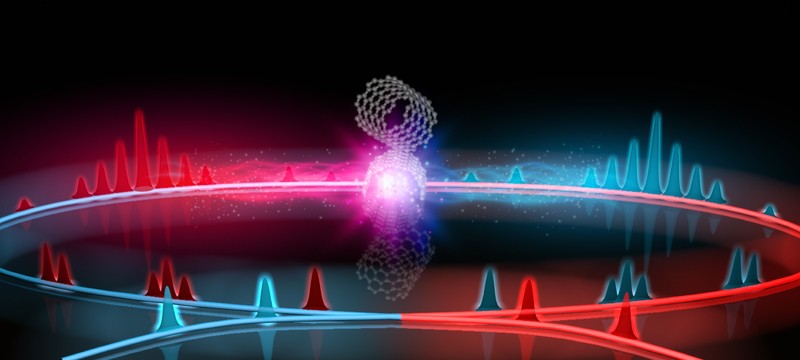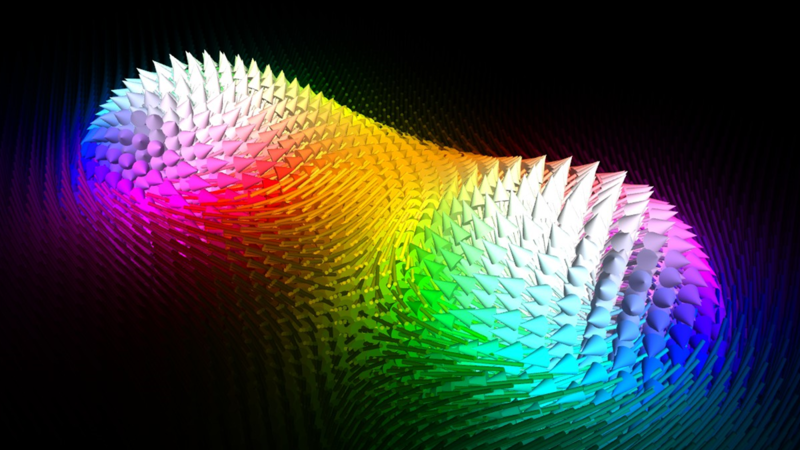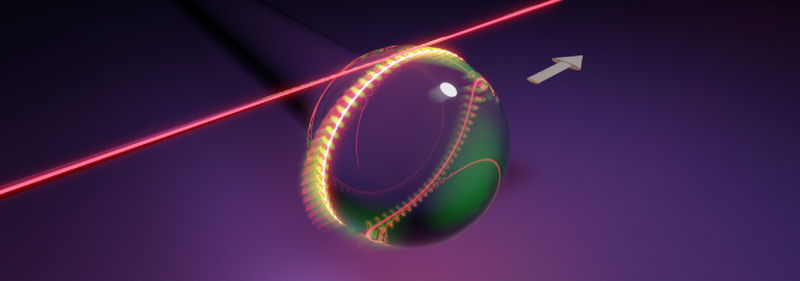Feature Image Contest
All authors of accepted papers are encouraged to submit a feature image to be used for the promotion of their article in social media and other media platforms. As a result, we have collected a large number of images over these past five years. As a proof for the most skeptical that physics can also be aesthetic, we launched our first edition of Feature image contest in February 2023. With this contest, we want to provide a bit of fun for our readers while acknowledging the creativity of our authors.
Our editors shortlisted the feature images from among the many submitted by the authors and our readers voted which was worthy to earn the coveted title of best physics image.
Congratulations to the contest winner and thank you to all who participated and voted!
We are pleased to announce the winner:
Image 10
 Counter-propagating ultrashort pulses travelling along a bidirectional mode-locked ring fibre. A stable bidirectional mode-locked laser is formed through modulation instabilities after 70k round-trips.
Counter-propagating ultrashort pulses travelling along a bidirectional mode-locked ring fibre. A stable bidirectional mode-locked laser is formed through modulation instabilities after 70k round-trips.
Kudelin, I., Sugavanam, S. & Chernysheva, M. Pulse-onset dynamics in a bidirectional mode-locked fibre laser via instabilities. Commun Phys 3, 202 (2020).https://doi.org/10.1038/s42005-020-00465-4
Image Credit: Maria Chernysheva
With the Runner-up:
Image 8
 All topologically protected Q8-colored links up to equivalence. Topologically protected links are supported by a variety of physical systems such as dilute Bose-Einstein condensates and liquid crystals.
All topologically protected Q8-colored links up to equivalence. Topologically protected links are supported by a variety of physical systems such as dilute Bose-Einstein condensates and liquid crystals.
Annala, T., Zamora-Zamora, R. & Möttönen, M. Topologically protected vortex knots and links. Commun Phys 5, 309 (2022). https://doi.org/10.1038/s42005-022-01071-2
Image Credit: Aleksandr Kakinen, Toni Annala, Mikko Möttönen
Shortlisted entries:
Image 1
 Artistic representation of a quantum superposition of time’s arrows. The hourglass symbolizes the flow of time. The downward and upward flow of water represent the forward and time-reversal processes. The gondolier represents the thermodynamic system subject to the quantum superposition of opposing time's arrows.
Artistic representation of a quantum superposition of time’s arrows. The hourglass symbolizes the flow of time. The downward and upward flow of water represent the forward and time-reversal processes. The gondolier represents the thermodynamic system subject to the quantum superposition of opposing time's arrows.
Rubino, G., Manzano, G. & Brukner, Č. Quantum superposition of thermodynamic evolutions with opposing time’s arrows. Commun Phys 4, 251 (2021). https://doi.org/10.1038/s42005-021-00759-1
Image Credit: IQOQI Vienna
Image 2
 Contributions of each geographical area to the global country distancing during the COVID-19 outbreaks. The contribution of each country is tracked by the impact of local restrictions on the global mobility network, which determines when and where the disease arrives.
Contributions of each geographical area to the global country distancing during the COVID-19 outbreaks. The contribution of each country is tracked by the impact of local restrictions on the global mobility network, which determines when and where the disease arrives.
Zhong, L., Diagne, M., Wang, W. et al. Country distancing increase reveals the effectiveness of travel restrictions in stopping COVID-19 transmission. Commun Phys 4, 121 (2021). https://doi.org/10.1038/s42005-021-00620-5
Image Credit: Lu Zhong
Image 3
 Order to disorder transition in 2D composites with Moirè patterns. With a slight change in the Moirè twist angle, the microstructure goes from periodic to quasiperiodic, and the transport properties switch from those of ordered to randomly disordered materials.
Order to disorder transition in 2D composites with Moirè patterns. With a slight change in the Moirè twist angle, the microstructure goes from periodic to quasiperiodic, and the transport properties switch from those of ordered to randomly disordered materials.
Morison, D., Murphy, N.B., Cherkaev, E. et al. Order to disorder in quasiperiodic composites. Commun Phys 5, 148 (2022). https://doi.org/10.1038/s42005-022-00898-z
Image Credit: Kenneth Golden
Image 4
 How plasma-solid interactions in fusion devices help resolve conundrums of plasma turbulence and access improved confinement.
How plasma-solid interactions in fusion devices help resolve conundrums of plasma turbulence and access improved confinement.
Dif-Pradalier, G., Ghendrih, P., Sarazin, Y. et al. Transport barrier onset and edge turbulence shortfall in fusion plasmas. Commun Phys 5, 229 (2022). https://doi.org/10.1038/s42005-022-01004-z
Image Credit: CEA / IRFM
Image 5
 Nanoscopic spin texture of magnetic bubbles in MnNiGa bulk amples. The nanoscopic magnetization patterns are revealed and quantified by single pass multi-frequency Magnetic Force Microscopy.
Nanoscopic spin texture of magnetic bubbles in MnNiGa bulk amples. The nanoscopic magnetization patterns are revealed and quantified by single pass multi-frequency Magnetic Force Microscopy.
Freitag, N.H., Reiche, C.F., Neu, V. et al. Simultaneous magnetic field and field gradient mapping of hexagonal MnNiGa by quantitative magnetic force microscopy. Commun Phys 6, 11 (2023). https://doi.org/10.1038/s42005-022-01119-3
Image Credit: Norbert H. Freitag
Image 6
 All-optical reversal of the magnetisation in an elementary ferromagnet. The ultrafast magnetization dynamics is triggered by irradiation with circularly polarized light and depends on the polarization of the incoming pulse.
All-optical reversal of the magnetisation in an elementary ferromagnet. The ultrafast magnetization dynamics is triggered by irradiation with circularly polarized light and depends on the polarization of the incoming pulse.
Duan, G., Zhao, X., Anderson, S.W. et al. Boosting magnetic resonance imaging signal-to-noise ratio using magnetic metamaterials. Commun Phys 2, 35 (2019). https://doi.org/10.1038/s42005-019-0135-7
Image Credit: Hanan Hamamera
Image 7
 Magnetic resonance imaging (MRI) using magnetic metamaterials. The magnetic metamaterial enables a marked boost in radio frequency field strength, and consequently in the signal-to-noise ratio of MRI.
Magnetic resonance imaging (MRI) using magnetic metamaterials. The magnetic metamaterial enables a marked boost in radio frequency field strength, and consequently in the signal-to-noise ratio of MRI.
Duan, G., Zhao, X., Anderson, S.W. et al. Boosting magnetic resonance imaging signal-to-noise ratio using magnetic metamaterials. Commun Phys 2, 35 (2019). https://doi.org/10.1038/s42005-019-0135-7
Image Credit: Xin Zhang
Image 9
 The light travelling along a tapered fiber drags a spherical microcavity. The dragging effect is enhanced by coupling the light in the fiber with the optical and acoustic whispering-gallery modes supported by the microcavity.
The light travelling along a tapered fiber drags a spherical microcavity. The dragging effect is enhanced by coupling the light in the fiber with the optical and acoustic whispering-gallery modes supported by the microcavity.
Qin, T., Yang, J., Zhang, F. et al. Fast- and slow-light-enhanced light drag in a moving microcavity. Commun Phys 3, 118 (2020). https://doi.org/10.1038/s42005-020-0386-3
Image Credit: Dr. Wenjie Wan, Mr. Tian Qin , Mr. Jianfan Yang , Fangxing Zhang , Yao Chen , Dongyi Shen , Wei Liu , Lei Chen , Xiaosh

